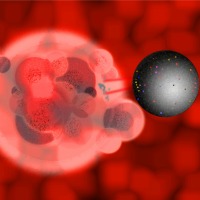Nanorobots Target Cancerous Tumours

Researchers have successfully used advanced nanotechnology to target cancer tumours with more precision than ever before. This is a big breakthrough in using nanocarriers in modern medicine. In this case, scientists used drug-laced bacteria, which magnetically hones in on its target. The study was conducted by multiple agencies including Polytechnique Montréal, McGill University, and the University of Montréal. Nanocarriers are the size of blood cells. This gives them the unique ability to travel through the bloodstream. These bacteria navigate their way to tumours, delivering drugs that target and kill the cancer cells. It appears now that nanotechnology has passed a critical threshold in the field of medicine.
Nanotechnology and Magnetically Guided Drugs
The definition of nanotechnology is the ability to manipulate things up to a 100 nanometers (a billionth of a meter is one nanometer). Nanocarriers are not new, but past attempts to use them have had mixed results, due to the small ratios of medicine being delivered to the target areas. The strain of bacteria used in the experiments is called Magnetococcus marinus or MC-1 for short. These bacteria carry drugs in micro-sized vesicles called nanoliposomes, which are the size of 80 nanometers.
The bacteria (MC-1 cells) used in the experiment has a special property. Inside the bacteria, are nanocrystals made of iron oxide. It’s this iron that has magnetic properties. In nature, the bacteria tend to travel along any natural magnetic field that leads them towards a low-oxygen environment where they can survive and multiply. It’s these attributes that give MC-1 cells the extraordinarily ability to navigate to the spots on tumours that are hypoxic (oxygen-depleted). These are vulnerable spots on tumours that previous treatment methods have not been able to kill. After the MC-1 cells are injected nearest to a tumour, the bacteria are guided by magnets, which are controlled by a computer. A magnetic field is generated and direct the bacteria to the hypoxic spots on cancer tumours. This method of delivering drugs is proving to target cancer tumours without damaging healthy tissue in the surrounding area or compromising the health of internal organs.
Defeating Hypoxic Cancer Tumours
In lab experiments, mice with colorectal cancer were given the treatment. The injection had to be near the target in order to maximise the number of nanoliposomes that came in contact with the surface of the tumour. The nanoliposomes vesicles carried about 70 drug compounds that the MC-1 cells would target. Certain regions of cancer tumours have unusual resistance to treatment. These regions are oxygen depleted or hypoxic and are resistant to drugs and other therapies. The study demonstrated that these regions can be penetrated, with up to 55% of the drug being delivered inside the tumours on the lab mice.
The results of this spectacular study may blow open the field of medical nanotechnology. The researchers proved they could use micro-organisms with magnetic control, carrying powerful drugs directly to cancer tumours. In the future, swarms of bacteria or other microorganisms could be used at an even more advanced stage. This will give doctors the medicine needed to one-day cure cancer, and potentially other diseases.